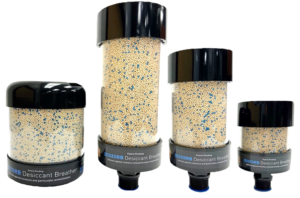
Desiccant breathers offer several benefits when used in equipment and systems. Here are some key advantages:
- Moisture control: Desiccant breathers effectively remove moisture from the air before it enters the equipment or system. By adsorbing water vapor, they help prevent the formation of condensation, which can lead to corrosion, degradation of lubricants, and other moisture-related issues. Maintaining a dry internal environment helps to preserve the integrity and performance of the equipment.
- Contamination prevention: The particulate filter in desiccant breathers captures solid particles, such as dust, dirt, and debris, from the incoming air. By preventing these contaminants from entering the equipment or system, the breather helps to protect sensitive components, reduce wear and tear, and minimize the risk of failures or malfunctions. This leads to improved equipment performance and reliability.
- Extended equipment life: By controlling moisture and preventing contamination, desiccant breathers contribute to the longevity of the equipment or system. They help to reduce the likelihood of corrosion, rust, and other damage caused by moisture, as well as the detrimental effects of solid particle contamination. This can lead to longer service life and lower maintenance costs.
- Reduced maintenance requirements: The use of desiccant breathers can decrease the frequency of maintenance tasks associated with moisture and particulate contamination. By actively removing moisture and capturing solid particles, the breathers help to keep the internal components cleaner and in better condition. This results in reduced maintenance needs, such as less frequent fluid changes, filter replacements, and component cleaning.
- Cost savings: The benefits provided by desiccant breathers, including extended equipment life and reduced maintenance requirements, can translate into cost savings over time. By minimizing the risk of equipment failures, downtime, and the need for costly repairs or replacements, the breathers contribute to overall cost-efficiency and improved productivity.
- Environmental protection: Desiccant breathers help maintain a clean and dry internal environment within equipment and systems. By preventing the entry of moisture and contaminants, they help safeguard the integrity of fluids and reduce the likelihood of fluid leaks or spills. This promotes environmental protection and reduces the risk of pollution.
Overall, desiccant breathers offer several benefits in terms of moisture control, contamination prevention, equipment longevity, maintenance reduction, cost savings, and environmental protection. They are a valuable investment for ensuring the reliability and performance of equipment and systems in various industries and applications.
